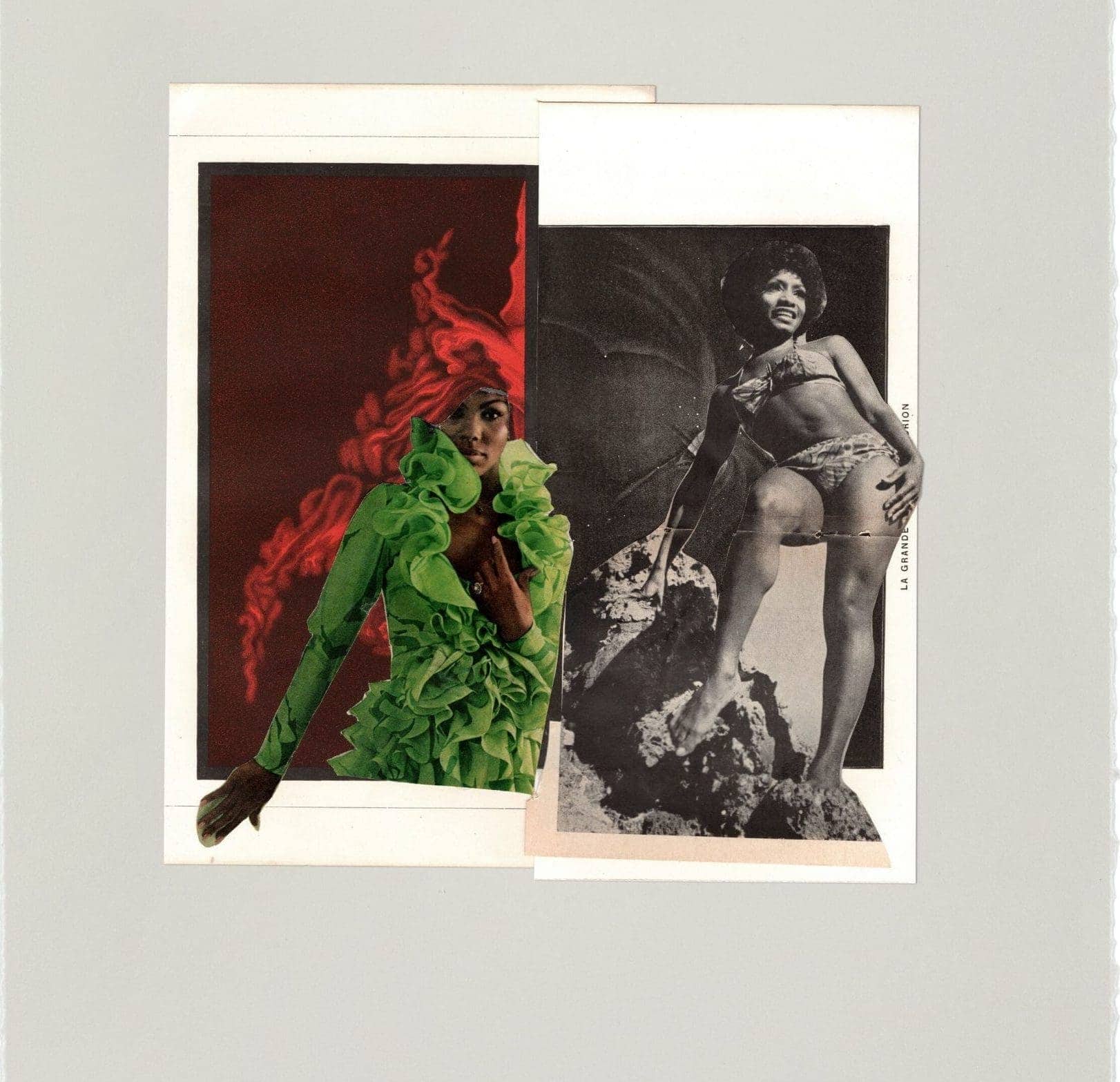

Lorna Simpson, California, 2019, Found photograph and collage on paper, 56.5 x 41.8 cm / 22 1/4 x 16 7/16 in, © Lorna Simpson, Courtesy the artist and Hauser & Wirth, Photo: James Wang
Having come to prominence in the 1980s with juxtapositions of text and staged images, Lorna Simpson continues to interrogate questions of identity, race, gender, and history in an ever-expanding multi-disciplinary approach.
Here, turning to collage – and a stack of Ebony magazines she has with her in quarantine – Give Me Some Moments sees Simpson inventing protagonists poised between portrait and anti-portrait; at once faces and pages and the palimpsests behind every face.
Give Me Some Moments sees Simpson inventing protagonists poised between portrait and anti-portrait
As the art world migrates online, there’s opportunity for some neat touches. Lorna Simpson’s Give Me Some Moments, hosted by Hauser & Wirth’s online Viewing Room, includes Artist Recommendations. The soundtrack to Simpson’s lockdown is Jason Moran.
The Texan jazz pianist’s blistering-blossoming trills are indeed a good fit for Simpson’s playful bricolage (as proved by their collaborations in the past.) Both artists go off in a million different directions, but they always take you with them.

Lorna Simpson, Lyra night sky styled in NYC, 2020, Collage on paper, 45.6 x 34.8 cm / 17 15/16 x 13 11/16 in, © Lorna Simpson, Courtesy the artist and Hauser & Wirth, Photo: James Wang
One thing leads to another, and I find myself queuing up Solange’s ‘Don’t Touch my Hair’. It seems just the right accompaniment; hair – that most political of physical attributes – is lit with flickering possibility in Simpson’s cut-and-paste portraits.
Especially incendiary is ‘Flames’ (2019). In this pair of collages, burning buildings take the place of coiffed wigs, as worn by women cut from ads in old Ebony magazines.
Simpson’s collages are simple, preserving much of the original advert’s composition; close-ups generate intimacy, inviting you to find the story
Domesticity meets state-of-emergency; seen from the midst of a global pandemic, KC Green’s ‘This is Fine’ meme (showing an anthropomorphic dog trying to act calm sipping coffee in a room engulfed in flames) comes to mind. Only, I don’t think Simpson would go in for such cynical irony; there’s much more to be got from ambiguity.
Simpson’s collages are simple, preserving much of the original advert’s composition; close-ups generate intimacy, inviting you to find the story. Yet scanning these women’s faces with heads ablaze, most of what you find is tinted with artifice, almost unreadable.
ArrayLorna Simpson, Flames, 2019, Found photograph and collage on paper; 2 framed collages, 48.3 x 36 cm / 19 x 14 3/16 in, © Lorna Simpson, Courtesy the artist and Hauser & Wirth, Photo: James Wang

Lorna Simpson, Solar, 2019, Collage on paper; 3 framed collages, 46.7 x 38 cm / 18 3/8 x 15 in, © Lorna Simpson, Courtesy the artist and Hauser & Wirth, Photo: James Wang
Whether the flames connote hot-headedness, repressed anger, destruction or purification is up for grabs. Much more pressing is the gesture of juxtaposition itself, and the experience of detachment it affords.
In ‘Solar’ (2019), red hair spills ink-like through a carnival headdress into solar flare. Heads are garlanded by strange, pink rock formations in ‘Illustration’ (2020). The model in ‘Lyra night sky styled in NYC’ (2020) wears a constellation map as a bouffant. Simpson isolates hair; then, resituates it.
Here, the tactility of those earlier works might have given way to a glossy kind of flatness, but there’s still an archive at play
Give Me Some Moments sees Simpson untangling a thread that can be traced back through her oeuvre. In works such as ’1978-88’ (1990) and ‘Wigs’ (1994) hair and hairstyles are contrasted in scientific taxonomies, alongside samples of words and texts we use to pin it down (for better or worse.)
Here, the tactility of those earlier works might have given way to a glossy kind of flatness, but there’s still an archive at play – attitudes towards African American hair interrogated this time with serendipity, with the urgency of what’s-to-hand.

Lorna Simpson, Construction, 2020, Collage on paper, 56.4 x 43.3 cm / 22 3/16 x 17 1/16 in, © Lorna Simpson, Courtesy the artist and Hauser & Wirth, Photo: James Wang
As Simpson explains, ‘the notion of fragmentation, especially of the body, is prevalent in our culture, and it’s reflected in my works. We’re fragmented not only in terms of how society regulates our bodies but in the way we think about ourselves.’ Wearing a wig, for example, is a deeply personal – and for many – political choice: some voices in the black community argue that to do so is to conform to a ‘white’ look; for others, a wig might be an instrument of metamorphosis.
In ‘Construction’ (2020), a woman’s head protrudes through a building site with all the primness of a postage stamp, a ladder tucked under her chin. Is she weighed down by her gangplank necklace, or ascendant as a monumental statue?
When it comes to mapping our identities in all their complex constellations, all we have are the textbooks we’re in
For all the ways society regulates our bodies, might there be something constructive about fragmentation? Dare I say, celebratory – noting the bunches of helium balloons floating through the exhibition?
When it comes to mapping our identities in all their complex constellations, all we have are the textbooks we’re in. Thankfully, then, we are bolstered by those prepared to throw them out the window.
You can view Lorna Simpson’s ‘Give Me Some Moments’ on Hauser & Wirth’s Viewing Room here.


